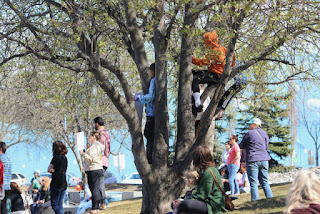The Supreme Court Docket for the Redistricting case is adding new documents.
The Board has two major documents.
- Motion to Stay Trial Court Order; Motion to Expedite Consideration of Motion to Stay
- Petition for Review
"Unlike the prior round of litigation, where the superior court identified regionalpartisanship in pairing South Eagle River with South Muldoon, the superior courtdeparts from the framework it previously adopted with a rambling decision that fails toarticulate what a constitutional “community of interest” is or a legitimate basis forinvalidating a district that this Court has previously held was compact, contiguous, and socio-economically integrated.7"
So, let's look at Singer's footnote 7.
"7 As Judge Rindner observed, "respect for neighborhood boundaries is an admirable goal," but "it is not constitutionally required and must give way to other legal requirements." Therefore, the districts containing the Eagle River area are not unconstitutional in any respect."
First, Judge Rindner was NOT talking about 2021 Senate District F. He was talking about 2002 House District 32. We'll get back to this point shortly.
Second, Singer ignores the implications of "must give way to other legal requirements." In the 2002 case, those other legal requirements were about having deviations that were too high. So, while neighborhood boundaries are "an admirable goal," if they mean the district has too high or too low a deviation, then you have to find other alternatives. In 2002 deviation meant neighborhood boundaries needed to be sacrificed. In the 2022 case, those other legal requirements include no partisan gerrymandering.
Singer continues:
"The superior court also ignores In re 2001 Redistricting Cases, where this Court rejected attempts to Balkanize the Municipality of Anchorage into separate areas for purposes of election districts. In that case, the Court reaffirmed that “communities within the Municipality of Anchorage are socio-economically integrated as a matter of law,” and that the community of Eagle River could be paired in a house district with the South Anchorage hillside.8 This Eagle River-South Anchorage hillside district was “not unconstitutional in any respect.”9"
Then, in the footnote 8, Singer tells us:
"Id. at 1091 (upholding House District 32, which spanned from the Eagle River Valley to the Anchorage hillside); See ARB Board Record at 10414 (2002 Amended Redistricting
Plan)."
Again, I say that the 2002 House District 32 was very different from 2022 Senate District F.
In those days, Eagle River and Chugiak weren't big enough for two House districts. The north of the Eagle River Valley district had to go to southern Mat-Su to get enough population for a second district.
In fact House District 30 captured most of the Eagle River Valley area. House District 32 (the one Singer keeps harking back to) stretches from the edges of District 30 down south to Whittier and into the Kenai Peninsula, getting enough population to be a whole district by taking some population from the Hillside.
BUT based on the only 2002 House maps I could locate, there are few if any residents of Eagle River in that district. If there are Eagle River residents, they are the leftovers once the district hit its target number of inhabitants. HD32 was called the Chugach State Park district. This was a compromise district that went to the Supreme Court and was accepted because of problems with deviations in other districts. It was a compromise under special circumstances.
From the Alaska Election Pamphlet 2002 Anchorage area here are the maps so you can see the context of that district.
Maps of
D 17 (ER) 18 (Military) =Senate I
D15 (Rural Mat-Su) D16 (Chugiak/Southern Mat-Su= Sen H
D32 (Huffman/Ocean View) D32 (Chugach State Park) =Sen P
This first map focuses on the Chugiak/Southern Mat-Su district 16. You can see a tiny District 17 on the lower left. That's Eagle River.
This wasn't an "Eagle River/Hillside" district as Singer portrays it. It was called the Chugach State Park district that reached to the outer edges of ER and down into the Kenai. It was a district that was trying to scrape up enough population to be an actual district.
It's sort of like how the Board majority characterizes HD 23 as the JBER district when it's really 1/3 north Anchorage Bowl.
I haven't been able to find better maps to pin this down more precisely. But it seems a point worth raising and exploring. I suspect the meme of an Eagle River/Hillside house district in 2002 that was constitutionally approved that floated around among the Option 3B supporters wasn't better supported than my points here.
Political-Gerrymandering And Zero-Sum Thinking
There are a number of issues to raise from the Board's motion to the Supreme Court and I just don't have the time to go through them all right now. But I do want to address this one. From Singer:
The upshot of the superior court’s order is that because it found a portion of the
Board’s previous 2021 Redistricting Plan invalid as a political gerrymander, the
Board’s new April 2022 Amended Redistricting Plan must also be a gerrymander. On this basis, the superior court orders the Board to adopt senate pairings advanced by and preferred by democratic leadership in the Alaska Senate.6 This is wholly inappropriate.
First, the judge didn't conclude that because there was political gerrymandering in the first plan that, ipso facto, the second plan is also gerrymandered. Judge Matthews addressed this question directly and at length. He concluded that given the intentional partisan gerrymandering the first time round, and given that the second time round the Board continued to create two Senate seats for Eagle River, the level of proof of partisan gerrymandering needed wasn't as high as it was the first time. The judge also cited an email from board member Simpson
"to an unknown number of contacts stating in part that the Court's Order "implies that what the court perceived as a political gerrymander must be replaced with a different political gerrymander more to their liking."118 (From Court Order p. 24)
While I suspect that Simpson was probably being sarcastic, he's an experienced attorney and should know better than to write such an incriminating sentence. Sarcastic or not, I suspect it was revealing of what he was thinking.
Second,
"On this basis, the superior court orders the Board to adopt senate pairings advanced by and preferred by democratic leadership in the Alaska Senate.6"
Let's see now. Option 2 was advanced by the East Anchorage plaintiffs, not the Democratic leadership. I'd note that Option 3B WAS drawn and advanced by one of the most partisan Republican operatives, and former Chair of the Republican Party. And supported by the three Republican appointed Board members.
I'd note that footnote 6 refers to "Senate Minority Leader Tom Begich’s text-message communications to a board member seeking to influence Anchorage senate pairings."
It seems the Board majority and its attorney are firm believers of the zero-sum way of thinking. It posits that what one person loses, the other person gains.
Here, Singer posits that if the judge takes away the ill gained extra Republican Senate seat that the majority 'won.' then that translates into an intentional extra Democratic seat for the enemy. Singer seems to assume here that the only reason the Board minority voted for Option 2 was to gain an extra Democratic seat. His evidence is a text message from Tom Begich, which he doesn't quote. This attempt by Singer to simply turn around and accuse the Board minority of doing what the Board majority did is classic Republican Rovian "Tactic #3: Accuse Your Opponent of What He/She is Going to Accuse You Of." At times it might be accurate, but the evidence against the Board majority is overwhelming while the evidence against the Board minority doesn't exist. Was there lobbying of the Board minority? Sure, but it was for specific things various constituents wanted, things other than partisan gerrymandering. It wasn't to get more people elected from a particular party as the actions of the Board majority are.
OK, enough for tonight, but there is plenty more there to chew on and spit out.






































